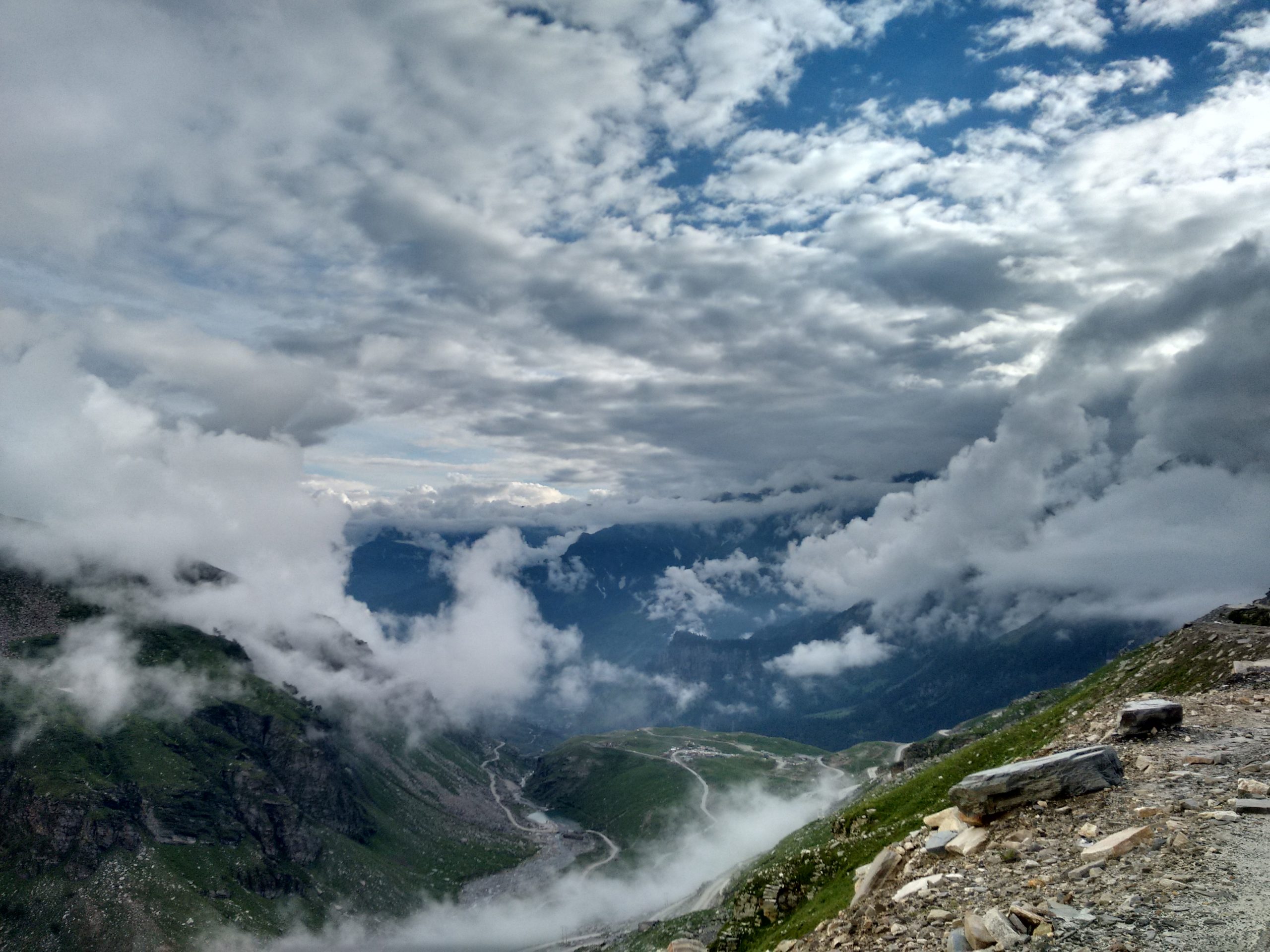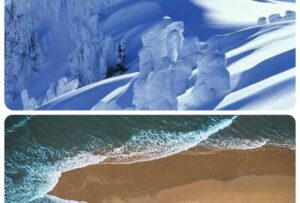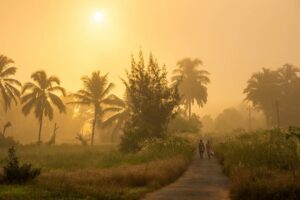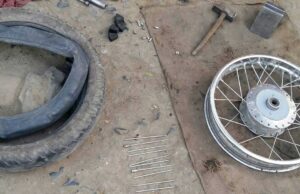To the North of India, lies part of the Himalayan Mountain range. The range is a source of the world’s three major rivers; nine of the ten highest peaks on earth and on a cultural level have shaped South Asia from ancient times. Its peaks are considered sacred to both Buddhism and Hinduism. Its landscape is harsh and spellbinding at the same time, and many travelers have returned to explore it environs time and time again with the exception of a few unlucky ones. Our journey begins in Manali- a tourist town situated in the Kullu valley of Himachal Pradesh. Each year the Manali Leh – Highway is resurrected from deep snow and ice to connect people living in the Lahaul valley, and further to Ladakh, that get shut out from the rest of the country during the winter months. Primarily having military strategic importance this highway or route is also thrown open to adventure enthusiasts and curious travelers, who make their way across five high altitude passes from Manali to Leh and Vice – Versa. Attempting minus temperatures at night, harsh sun during the day,landsides and unpredictable weather, to experience a hidden world of nature far from the pandemonium of traffic jams, crowded streets, pocket friendly connectivity and the vices of urban living. It’s a region that leaves you to take care of yourself.
Its 7am on a slightly overcast and drizzly morning at Naggar town near Manali. The air is tense but eager around me as I load luggage into a pickup trip hired for the riders and my team on our journey to Leh. The riders who are to be my companions and customers for the next nine days have made long journeys to be here and the overcast sky and my urge for this go as smoothly as possible are the only two things showing signs of breaking over into a heavy downpour. The 500 cc bullets have been prepped by Sonu -our team mechanic the previous day. In a sense, the bikes are brand new having only covered a few thousand kilometers since their purchase in Srinagar. Forest Green and decorated with prayer flags they are the most crucial link in the journey and stand handle bar to handle bar in the parking lot of the Naggar castle hotel, wet from the morning dew. I light a cigarette and inhale deeply, as the riders put on their gear and make ready for the day’s journey.. The trip has begun.
It’s a been a rocky back and forth game of who will bend first between the unregistered Manali and Leh bike association and as we attempt the Rothang Pass I’m hopeful for a smooth passage across the La and nice day of riding ahead, without anybody from the Manali union stopping our Ladakh registered bikes. Only the crossing of Rothang will tell…
Rothang La or Rothang Pass is a high altitude pass that infamous more recently for it traffic jams than beauty. At 3900 M in altitude , the rather innocuous sounding name of Rothang has a more dubious meaning to it – In much earlier times a number of travelers died while traversing this pass, mainly due to temperamental and harsh weather conditions – hence Rothang earned its name which translates to ‘pile of corpses’. It lies on the eastern Pir Panajal range and connects the Kullu Valley with Lahaul and Spiti.
In today’s time it’s a popular day drive for tourists coming to manali and has the trappings of any popular destination in India. As we approach Rothang the weather does not play foul and we are greeted by some jaw dropping views and sights.

By late afternoon we have crossed into the Lahaul valley , and approaching the village of Jispa where we check into our hotel for the night and bring out the drinks and conversations about the day just gone by and the journey ahead. Landslides, Police check posts, riding alongside sheer cliff drops, photo opportunities, acclimatization and jokes about back home, come out in questions and answers among the group and the team. It’s a quiet night under a starlight sky in a Himalayan village – the sound of our voices serving as warmth and appreciation to one another. Dinner is served and soon the plan for tomorrows ride will unfold.
It’s a clear morning next day and at 9:00 am we have finished a nice breakfast, prep for the day and looking forward to attempt the two crossings on our way to Deepak Tal, Suraj Tal and then Baralacha La. After a signing in at the police check post at Darcha we start climbing towards the water crossings. Given the amount of snowfall the Himalayas receive there is still enough of melt taking place even after the summer months kick in and the road is cleared, leaving the melting ice and snow nowhere else but to flown downwards from above and onto the road in front us. Often tricky and slightly perilous the river crossings are true test of your skill on a machine and kind reminder that it’s in human nature to help someone else stranded or stuck in a situation. By Mid noon a slow and steady stream of melt can mutate into a fast flowing, deep and dangerous torrent of freezing cold water running off the cliff edge, so it is always safer to make the crossing in the morning. Watching each rider’s tense face before the crossing and a smile of triumph after the crossing is an experience that often reminds me of how obstacles that seem scary need to be attempted to understand the difference. With wet shoes and bolstered confidence we pushed on towards a break at the serene Deepak Tal and towards the mighty Baralacha La.

Baralacha La tops of at a height of 16,040 feet or 4890 M. Consider that you ride, drive or cycle at this altitude and very few experiences come close to the excitement or worry that things can go beautifully or badly. Located in the Zanskar range, Baralacha La connects Himachal Pradesh to Ladadkh. The name means summit and the cross routes from Spiti, ladakh, Zanskar and Lahaul meet here – making it a part of the ancient trade routes in times gone by.
Prayer flags and white scarves , stones piled one on top of the other on the ground, biting cold and rarified air greet you as you approach Baralacha La , a yellow concrete Marker by the BRO lets you know that you have arrived at 16000 + feet above sea level. It’s an otherworldly experience to share with your companions as you tie a prayer flag and exchange your new white scarves for an old one already tied to the flags. You do it to seek blessings and good fortune as you make your way through the mountains. We spent not more than 15 minutes at the top, taking pictures and looking around and down below. Few places on earth I guess humble you in a way that you are aware of how small your human form actually is compared to earth element of Mother Nature. As we descended we made a stop for lunch at Bharatpur. Sitting underneath tarpuline covered tents that cast a psychedelic effect on everything around you we ate a simple lunch of beans, mutton and rice. We were all slightly exhausted from the rarified air and the uneven and bumpy roads but I was glad that we successfully crossed the pass and were on our way to Sarchu for the night.
I could see one of the riders showing early signs of AMS and watched him closely during lunch for further symptoms but nothing as yet only the evening would tell if the team and I had problems later on. We put our boots back on, smoked cigarettes and rocked up and down on the bumpy road for the next 30 kms to Sarchu.
Sarchu is literally in the middle of nowhere and the only reason it can be located on a map is because it is a major halt point for accommodation and rest on the Manali – leh Highway. It’s sits on a flat plain at 14000 feet and, a place where more often than not you are left in the middle of nowhere to combat the symptoms of AMS if they set in. Acute mountain sickness is an illness that can affect mountain climbers, hikers, skiers, or travelers at high altitudes, usually above 8,000 feet (2,400 meters) and is caused by reduced air pressure and oxygen levels at these altitudes. Few people will tell you that they had a comfortable time at Sarchu primarily because it cold, you sleep in a tent and the food served by the campsites are dismal. By dinner the group had already begun to feel the effects of the cold. As night drew closer Sanju our team guide had to put one of the riders on oxygen to stabilize his symptoms and within an hour another rider from our team started feel the symptoms of AMS, and we had to get her on oxygen as well. However the spirit of the evening was not completely lost and before dinner time, both riders were looking much better and we shared our day’s experiences over dinner, feeling warm under several layers of clothing and a little apprehensive about how the dropping temperatures would treat each one at night. The Next morning everyone woke up to a nice hot breakfast and recounted their experiences of trying to get sleep and eventually falling asleep out of exhaustion. Looking back at it the ride from Manali to Leh is not a luxury vacation, it’s an adventure, a challenge, a test of your spirit against the elements.

The next morning we headed closer to Leh and deeper into the Himlayas. Our destination was the capital of Ladakh – the town of Leh . Three more mountain passes lay ahead surrounded by snow covered peaks towering above us, dirt roads testing us, brilliant blue skies that would spellbind you (if you chose to look long enough), noiseless valleys and the wind kicking up sand eroded from the mountains all around – their deep brown and green sides leading the imagination to form faces and geometric patterns. Long serpentine trails from landslides and deep gorges. All of it combined to create a visceral feeling that permeates through the journey. The plan was to ride to Tso Kar or Tso Kar Lake to spend the night at a campsite there, en-route we would attempt two of the three mountain passes, martian like landscape just before entering a place called Pang and then finally the More Plains, which runs for 30 kms in a straight flat plain all around you, no construction, no habitation – nothing. We stopped at Pang for lunch during which the sky was overcast and a light drizzle kicked in. Pang is another stop point like Sarchu and due to the fact that it’s lower in altitude (in comparison) spending a night here is an easier option. The food options that you have on the entire highway route are limited to Noodles , Noodle soup or Thukpa , steamed dumplings or momos , eggs , instant noodles and sometimes if you’re lucky mutton, but after all that riding and crossing Nakee La and Lachlung la , menu options were the last thing on everyone’s mind as we ate. We soon left Pang and reached the More plains, The road here really lets you push the top end of the bikes and after riding through potholes, sand and tight turns previously, the long unending straights were a welcome sight and feeling. Not one rider held back on this stretch That evening we reached Tso Kar , thoroughly spent from the days riding.
We were now a day’s ride away from Leh and that evening we rode to the lake and sat by its salty shore, chatting, taking pictures, looking out into the distance and allowing the noiseless surrounding to settle on us like a warm hug. Now back in the city with its traffic, televisions, pace and distractions , the calm of that evening sits fresh in my mind, urging me to go back once again to re-live that silence, often hard to come by in an urban setting.
By 10 am the next day we had reached the top of our fifth and final pass called Tanglang La. The climb up all these passes have been challenging and more so on the motorcycles that struggled because of the rarified air, but still the bikes were doing fabulously well and everyone’s spirits were high. Looking down from the pass top, I could see a winding tar road leading down into the valley and snow covering the landscape below, the entire experience was sublime and it slowly started to sink in that the town of Leh would soon be reached. The riders were all doing well and really starting to get into the feel of riding the bikes and the dirt roads. Me and the team were a bit tired but soon knew that a bit of rest was in store for us and looking forward to it, we set off to meet Leh.
If the grandeur and the solitude of the Manali- Leh highway will leave you calm, introspective, elated and tired all at once, entering into the town of Leh will transport you to a different time – Maybe an older time, a simpler one. Small whitewashed houses with thatched roofs, fields of barley and wheat around them, the Stok Palace, the simple grandeur of the Thiksey Gompa – leaves you with a feeling of coming into another time and place. Though with tourism to this region catching on and more room being made to accommodate this surge of visitors – a contrast becomes evident as you get to the city centre. While this contrast between the rural Leh and the town centre it is not entirely disenchanting, I wonder sometimes at the difference between today’s times and when Leh was once a trading post on the silk road, removed from the commercialization of tourism and traffic, hotels and travel agencies , politics and the military. In the coming days we would travel to valleys of Nubra and Pangong but more on that in another post as we traverse from Leh and into Srinagar – on the only other road that connects Leh with the rest of India.





